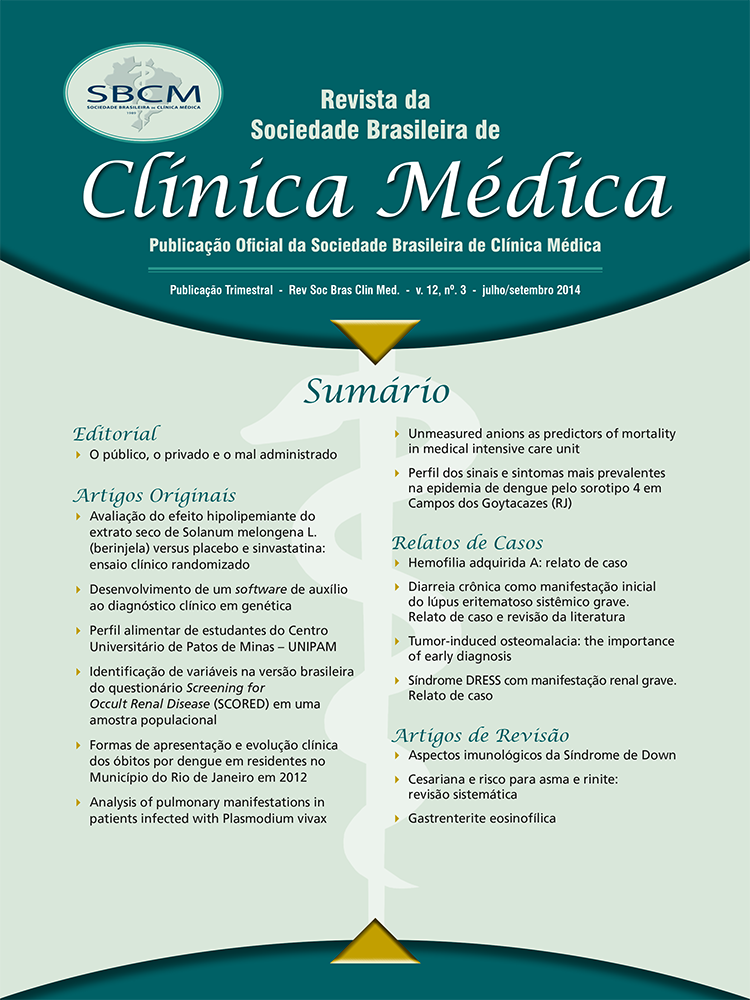Unmeasured anions as predictors of mortality in medical intensive care unit
Main Article Content
Resumo
BACKGROUND AND OBJECTIVE: The present study aimedto evaluate the utility of variables that represent unmeasuredanions (anion gap, anion gap corrected for albumin, anion gapcorrected for albumin and lactate, base excess and modifiedbase excess) to predict mortality in medical intensive care unitpatients. METHODS: This prospective study included 156consecutivepatients admitted to a medical intensive care unitin a Medical school hospital between August 2006 and June2007. Serum levels of potassium, sodium, chloride, C-reactiveprotein, albumin, and lactate were measured. Variables that representunmeasured anions and APACHE II score were calculated. RESULTS: Among the studied patients, 60.9% were male,and mean age was 59.2±17.2 years. Mortality rate was 31.4%.Spearman’s test showed correlation among unmeasured anionsand lactate. Comparison between survivors and non-survivorsshowed differences in length of intensive care unit stay, APACHE II score, albumin, C-reactive protein, lactate, anion gap correctedfor albumin, base excess, and modified base excess. Anion gapcorrected for albumin, base excess, and modified base excess arepredictors of medical intensive care unit mortality; however,theirs areas under the ROC curves are smaller than APACHE II score and C-reactive protein. CONCLUSION: Variables thatestimate unmeasured anions, such as anion gap corrected foralbumin, base excess, and modified base excess, can be used topredict mortality in medical intensive care unit patients.
Article Details
Declaração de Direito Autoral
Eu (nome do autor responsável) _______________________________________________ declaro que o presente artigo intitulado ___________________________________é original, não tendo sido submetido à publicação em qualquer outro periódico nacional ou internacional, quer seja em parte ou em sua totalidade. Declaro, ainda, que uma vez publicado na revista Revista da Sociedade Brasileira de Clinica Médica, editada pela Sociedade Brasileira de Clínica Médica, o mesmo jamais será submetido por um dos demais co-autores a qualquer outro meio de divulgação científica impressa ou eletrônica.
Por meio deste instrumento, em meu nome e dos demais co-autores, cedo os direitos autorais do referido artigo à Revista da Sociedade Brasileira de Clinica Médica, e declaro estar ciente de que a não observância deste compromisso submeterá o infrator a sanções e penas previstas na Lei de Proteção de Direitos Autorias (n 9610 19 de fevereiro de 1998) que altera, atualiza e consolida a legislação sobre direitos autorais e dá outras providências. Disponível em: http://www.planalto.gov.br/ccivil_03/leis/l9610.htm
|
_________________________ |
___________________ |
|
Local, data |
Assinatura |
SOCIEDADE BRASILEIRA DE CLÍNICA MÉDICA
CNPJ/MF 062.279.617/0001-45
Rua Botucatu, nº 572, cj. 112, São Paulo, SP
Download da Declaração de Direito Autoral.
